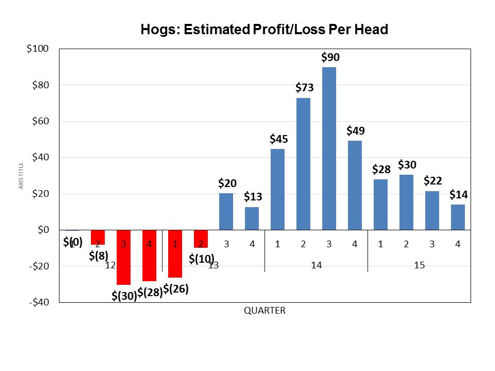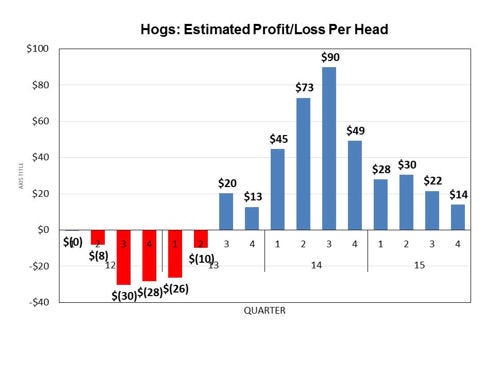
Growing up in northern Illinois, hogs were the mortgage lifters at our farm. They put three kids through college and helped my dad buy the home place from my grandpa.
Turns out hogs are hot again – really hot. After suffering years of low prices and high feed costs, U.S. hog farmers are enjoying record profits – and should well into the future. Livestock agriculture should do well through 2020, predicts Purdue economist Chris Hurt.
"Right now we've never seen anything like this," he says. "In the third quarter of this year U.S. hog producers will make $90 profit per head. In the second quarter they averaged $73 profit per head."

We're in the money: record profits for hog farmers, with positive expectations through mid-year 2015.
All that profit should translate into more pigs, bringing some relief to retail pork prices. "I've never seen any producer withstand those kinds of profits and not expand," Hurt says.
Income for Indiana farmers with livestock grew from nearly zero in 2012 to $860 million, a six fold increase.
Porcine Epidemic Diarrhea Virus may be throwing a wet blanket on this expected expansion. And it may be making those profits evaporate for those hardest hit by the tragic disease.
As of June 1, there were 62.1 million hogs and pigs on U.S. farms, the lowest inventory since 2007, according to the latest Quarterly Hogs and Pigs report published by USDA.
• Between March and May 2014, 27.4 million pigs were weaned on U.S. farms, down 5 percent from the same time period in 2013.
• U.S. hog producers intend to have 2.89 million sows farrow between June and August 2014, and 2.88 million sows farrow between September and November 2014.
• From March through May 2014, U.S. hog and pig producers weaned an average of 9.78 pigs per litter.
• While the national hogs and pigs inventory decreased since June 2013, growers in Texas, South Dakota and Michigan increased the number of hogs and pigs in their states.
Hog profitability began picking up speed when corn prices began to fall last summer, and it hasn't stopped since. But surprisingly, the USDA report showed no expansion in breeding herd animals.
"That's a surprise," says Hurt. "The other surprise is that we expected March/May farrowing intentions to be higher, but actual farrowing numbers were down fractionally, indicating no expansion."
NASS figures also indicate PEDV is still not under control.
"We started to pick up 2% death loss pigs per litter last October; by December it was up to 6%, by March it was up to 8%, and 5% by May," says Hurt. "Warm weather may have reduced death loss but it's not under control yet."
Kevin Bost, President of Procurement Strategies in Des Plaines, Ill., says he has the utmost respect for USDA numbers, yet, "for one of the first times in my career I can say there's something I don't understand, and that is the decline in farrowing from winter to spring. That number stands out as questionable. Going back to 1975 I can find only one other year where those numbers declined at all, and never this much.
"Why would that happen, when we have extremely good profitability? I don't think you can blame it on PEDV because that would impact pigs per litter. Profitability has been quite good for almost a year now. I don't understand and frankly, I don't believe it. The profitability is there. If anything there might be an incentive to overbreed to compensate for the PEDV loss."
Weighty profits
It costs about 50 cents to put on a pound of pork, which is worth 90 cents right now, so there is enormous incentive for adding weight to pigs, adds Chris Hurt.
Hurt says hog farmers will make around $49 per heat profit in 2014 fourth quarter, then average about $28 per head profit in the first half of 2015.
"It would be very difficult to see producers not want to do something to reduce their income tax liability this year, such as get into the expansion business," he says. "And because we see no expansion in the breeding herd, at least according to USDA, I do believe this extends the positive time frame for profitability.
"There's going to be a lot of income from pork producers so it's not too early to get their CPA thinking about income tax management. By the end of the year that cash flow is going to put them in a really strong financial position."
About the Author(s)
You May Also Like






